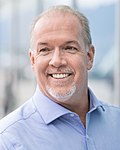
Back Γενικές εκλογές στη Βρετανική Κολομβία (2017) Greek Elecciones provinciales de Columbia Británica de 2017 Spanish Élections générales britanno-colombiennes de 2017 French
| |||||||||||||||||||||||||||||||||||||||||||||||||
87 seats in the Legislative Assembly of British Columbia 44 seats were needed for a majority | |||||||||||||||||||||||||||||||||||||||||||||||||
|---|---|---|---|---|---|---|---|---|---|---|---|---|---|---|---|---|---|---|---|---|---|---|---|---|---|---|---|---|---|---|---|---|---|---|---|---|---|---|---|---|---|---|---|---|---|---|---|---|---|
| Opinion polls | |||||||||||||||||||||||||||||||||||||||||||||||||
| Turnout | 61.2%[1][2][3] | ||||||||||||||||||||||||||||||||||||||||||||||||
| |||||||||||||||||||||||||||||||||||||||||||||||||
 Popular vote by riding. As this is an FPTP election, seat totals are not determined by popular vote, but instead via results by each riding. Click the map for more details. | |||||||||||||||||||||||||||||||||||||||||||||||||
| |||||||||||||||||||||||||||||||||||||||||||||||||
The 2017 British Columbia general election was held on May 9, 2017, to elect 87 members (MLAs) to the Legislative Assembly to serve in the 41st Parliament of the Canadian province of British Columbia. In the 40th Parliament prior to this general election, the British Columbia Liberal Party formed the government under the leadership of Christy Clark, while the British Columbia New Democratic Party (NDP), under the leadership of Adrian Dix and then John Horgan, formed the Official Opposition; the Green Party of British Columbia were also represented in the legislature with sole MLA and later leader Andrew Weaver.
It was the first election contested on a new electoral map completed in 2015, and the total number of constituencies had increased from 85 to 87. New districts were added in Richmond and Surrey, while the boundaries of 48 existing electoral districts were adjusted.
The election saw no party win a majority of seats for the first time since the 1952 election: the Liberals won 43 seats, the NDP won 41 seats and the Greens won three seats. After a period of negotiations, the Green Party agreed to provide confidence and supply to an NDP government on May 29. In response, Clark indicated she would remain in office and seek the confidence of the legislature. On June 29, Clark's speech from the throne was voted down, and Lieutenant Governor Judith Guichon invited Horgan to form a government. On July 18, Horgan became the new premier, while Weaver and the other Green MLAs did not join the Cabinet or take any official roles in the new government.
The election was notable in that it marked the end of the Liberal majority government that had led the province since the 2001 election, and the first election in Canada at the federal or provincial level that saw more than one member of a Green party elected.[5][6]
- ^ "Results by Electoral District" (PDF). Elections BC. Archived (PDF) from the original on December 9, 2018. Retrieved December 7, 2018.
- ^ "Results by Electoral District". CBC News. Archived from the original on October 6, 2019. Retrieved December 7, 2018.
- ^ "Results by Electoral District". Global News. Archived from the original on December 9, 2018. Retrieved December 7, 2018.
- ^ McElroy, Justin. "NDP Leader John Horgan to be next premier of British Columbia". CBC News. Archived from the original on June 30, 2017. Retrieved June 30, 2017.
- ^ McElroy, Justin (May 9, 2017). "B.C. Liberals hang on to power, could form minority government". CBC.ca. Archived from the original on May 12, 2017. Retrieved May 12, 2017.
- ^ Johnson, Lisa (May 10, 2017). "Greens celebrate 'historic' B.C. wins amid minority uncertainty". cbc.ca. Archived from the original on May 10, 2017. Retrieved May 12, 2017.
Cite error: There are <ref group=n> tags on this page, but the references will not show without a {{reflist|group=n}} template (see the help page).
© MMXXIII Rich X Search. We shall prevail. All rights reserved. Rich X Search


